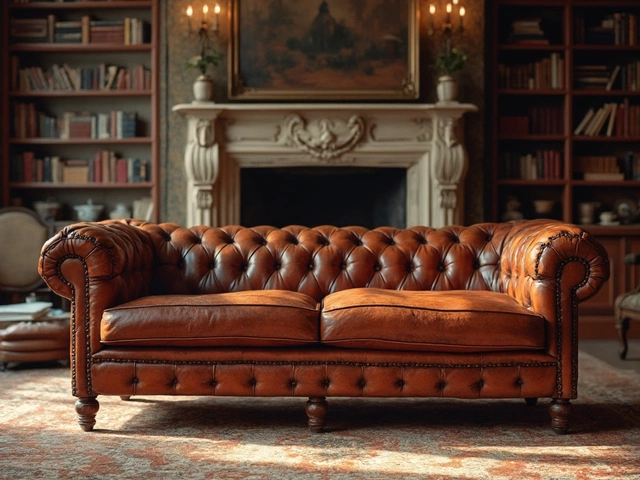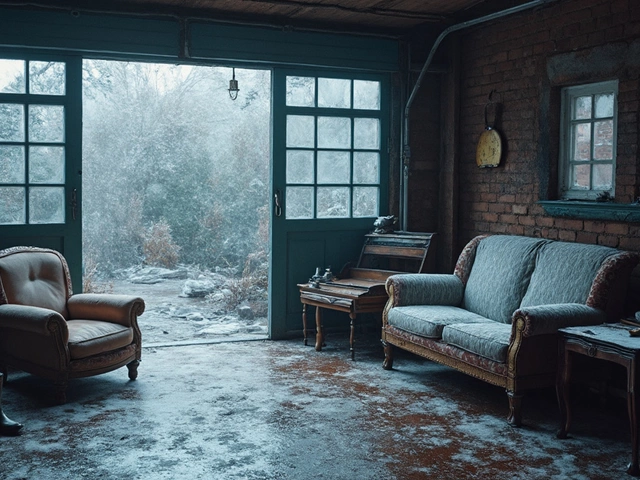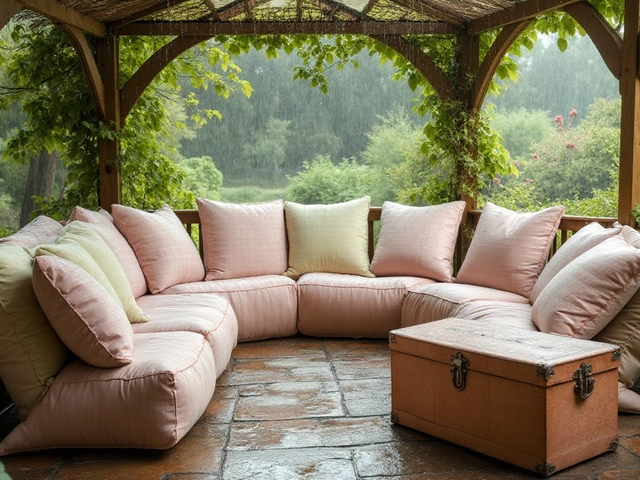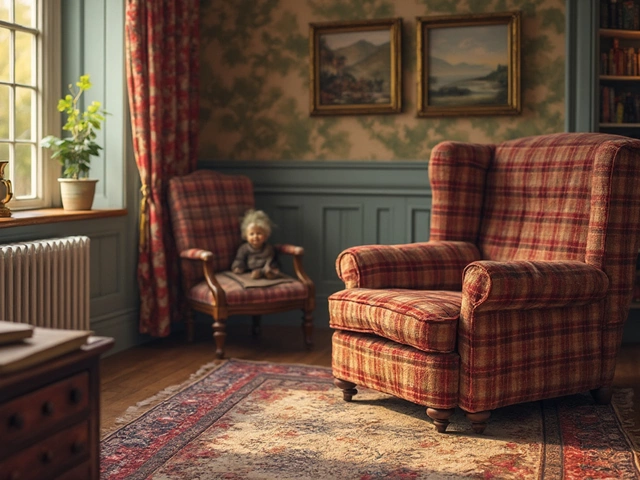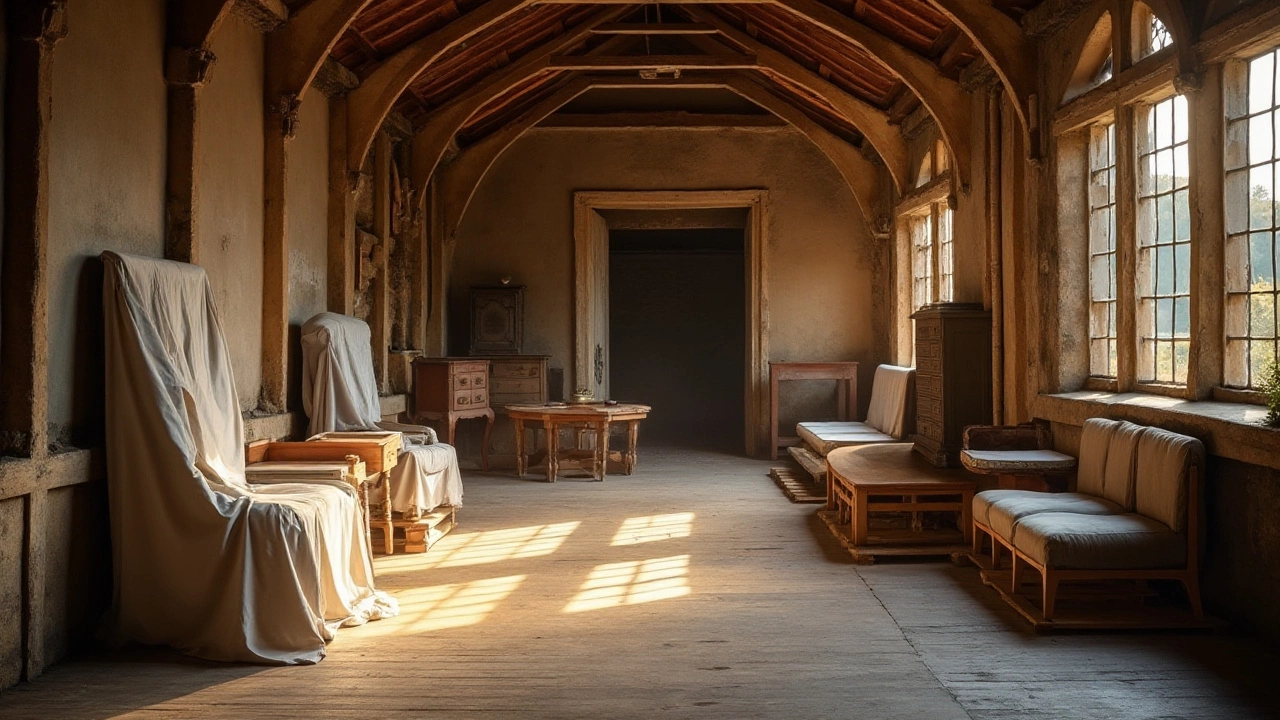 31
Jan,2025
31
Jan,2025
Storing furniture can be an intimidating task, especially when you're dealing with non-climate controlled spaces. The absence of regulated temperatures and humidity levels can be challenging for maintaining your beloved possessions in pristine condition. But with a few clever strategies and the right knowledge in your toolkit, you can ensure your furniture survives, and even thrives, during storage.
In this guide, we'll navigate the ins and outs of safe furniture storage in non-climate controlled spaces. We'll explore the potential risks and, more importantly, how you can mitigate them. From preparing your furniture for the big move to ensuring enough air flows through your storage unit, you'll be armed with the tools to keep your items in good health. Let's jump into the world of furniture storage and learn how to do it right.
- Understanding Risks of Non-Climate Controlled Storage
- Preparing Furniture for Storage
- Choosing the Right Materials for Protection
- Strategic Placement Tips
- Importance of Ventilation
- Storage Alternatives and Solutions
Understanding Risks of Non-Climate Controlled Storage
When you consider storing furniture in a space that lacks climate control, you are essentially embarking on a journey fraught with certain risks. These risks predominantly revolve around the unpredictable and often harsh environmental conditions typical of unregulated storages such as garages, sheds, or similar units. One of the primary challenges is temperature fluctuation. Unlike climate-controlled spaces, where temperatures are maintained at a steady level, non-climate controlled storage areas can experience extreme highs in summer and bitter lows in winter. These fluctuations can lead to the expansion and contraction of materials, which over time, could result in warping or cracking, particularly in wooden furniture. An important factor often overlooked is humidity. Excess moisture in the air can lead to mold and mildew, which is an insidious enemy of organic materials like wood and fabric. This can cause fabrics to become discolored, musty, and even lead to rot in wood sections.
Another risk involves pests, as non-climate controlled storage units are frequently more accessible to them. Rodents and insects look for shelter and sustenance, and furniture, especially the wooden and upholstered kind, provides both. Once infested, furniture damage can be extensive and costly to rectify. Furthermore, dust accumulation in these environments is a given, and it can settle into the cracks and crevices of your furniture, potentially scratching surfaces or degrading materials over time. Check this report from the Self Storage Association:
“Many storage users underestimate the impact of environmental factors on their possessions, leading to unexpected deterioration over periods of long storage.”With all these factors in mind, one might consider adopting a proactive approach, ensuring furniture is sealed and protected properly even before storage. Many experts recommend using protective covers, such as old blankets or furniture-specific coverings, to mitigate some of these risks. This step may help ward off dusty layers and insect intrusion, as well as provide a minor buffer against fluctuating temperatures and humidity. These are but a few of the real dangers facing furniture not stored under regulated conditions, making their understanding critical for effective furniture storage.
Preparing Furniture for Storage
Taking the time to properly prepare your furniture for storage can make a world of difference in preventing damage and preserving each piece’s longevity. Begin by cleaning each item thoroughly. Dust, grime, and oils can erode surfaces over time, especially in a non-climate control environment, where fluctuations in humidity can exacerbate these effects. Use a mild detergent or a specialized cleaner suitable for the material. Wooden furniture, for example, benefits from a polish or wax to create a moisture barrier. Leather items would appreciate a conditioner to maintain their suppleness. It’s important to allow any treatments to dry completely before taking the next preservation steps.
Disassembly can significantly reduce the risk of breakage during transport and storage. Remove legs from tables and chairs when possible, take apart bed frames, and detach any fittings and accessories. Each small part should be stored in labeled bags to avoid the frustration of mismatched components months later. Not only does this save space, but it also minimizes pressure points that might warp or crack under the weight of other items.
Once disassembled, wrap each piece with furniture covers or moving blankets. Although plastic coverings seem like a simple solution, they can trap moisture and promote mold, so it's better to use breathable fabrics. Don’t forget to use corner protectors where necessary; these often overlooked guardians can prevent nicks and scratches—common complaints from attempts to maximize compact storage.
It’s also worth investing in some protective materials for any glass or ceramics. Bubble wrap and packing paper are your best allies. By creating a soft buffer zone around these items, you reduce the risk of incurring chips or worse. If practical, cardboard boxes are a fantastic additional layer of defense, not just for smallglass pieces but even for detached shelves or doors. Cushion them properly, and you can stack them safely, which optimizes the storage space effectively without courting disaster.
"An ounce of prevention is worth a pound of cure," noted Benjamin Franklin, and when it comes to storing furniture, this adage rings particularly true.
Labeling is not just for the super organized. Once your items are packed, clearly label everything. This ensures ease of access and reduces handling time and mishandling when the time comes to retrieve them. Labels indicating fragility are especially crucial for protection from unwarranted rough treatment.
Choosing the Right Materials for Protection
Storing furniture in a non-climate controlled space necessitates a vigilant approach to selecting the right protective materials. The primary aim is to safeguard your precious items from dust, moisture, and unexpected temperature shifts. One might consider using fabric covers or drop cloths, as they offer breathability which is key for allowing air circulation around the furniture. Plastic covers, while tempting due to their water-resistant nature, could trap moisture and inadvertently lead to mildew—certainly a situation you’d want to avoid. It’s the kind of balance act between accessibility and protection that’s crucial.
Wooden furniture is particularly sensitive to storage conditions; fluctuations in humidity could lead to warping or cracking. Employing wax or polish on wooden surfaces before storing can form a protective seal that reduces the risks associated with moisture absorption. Metal pieces, on the other hand, should be treated with anti-rust spray coatings. It’s a wise step to invest in quality materials—a minor investment upfront can save you headaches and money down the line. A clever trick is to cover the floor of your storage space with a tarp or a plastic sheet—this forms a barrier against unwanted moisture creeping up from below.
Hints from the Experts
As the distinguished furniture restorer Joseph Tanner once remarked,“When it comes to preservation, it’s all about maintaining the original condition as much as possible. Your materials should breathe yet shield, protect yet not strangle.”Another expert tip is to elevate your furniture off the ground, perhaps by setting them on wooden pallets. This can prevent potential water damage and facilitates airflow. Remember, spacing is as critical as the materials used. Avoid stacking items directly on each other, as this can cause pressure marks and unwanted outcomes.
A good checklist for furniture storage also includes bubble wrap and moving blankets for added padding on delicate surfaces. Craftsmanship often involves more than just solid build; it involves the tender care that extends its life. Let's assume you have cushioned furniture pieces; consider layering them with acid-free paper to prevent any chemical reaction potential that might degrade the fabrics over time.
Consider these suggested materials and tactics your toolkit. They offer both short-term preventative measures and long-lasting benefits. Though it might seem like a chore, ensuring that the proper materials are used is a proactive step toward maintaining the integrity of your pieces in a non-climate controlled space. After all, ensuring a safe retreat for your furniture today means enjoying it for generations to come.
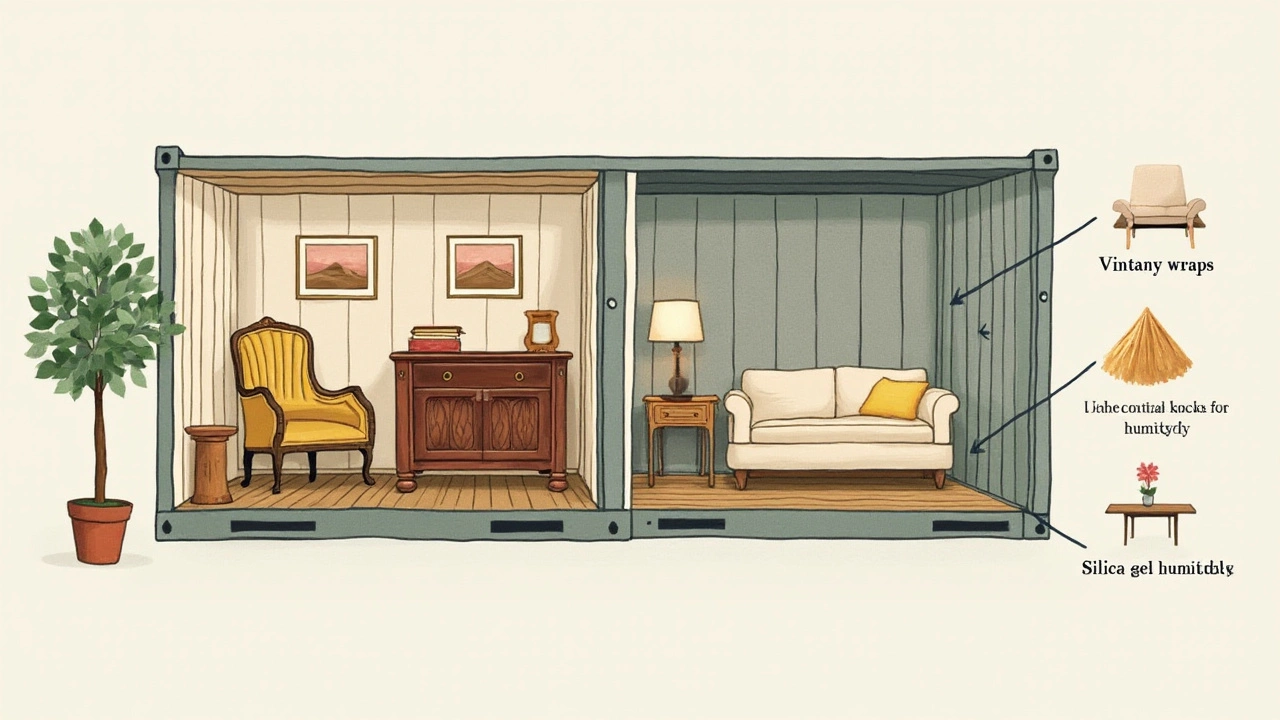
Strategic Placement Tips
Finding the most effective way to position your furniture in a storage unit without climate control involves more than just stacking items together. It's about maximizing the space while minimizing risk. Temperature and humidity fluctuations are formidable foes in these environments, so the way you arrange each piece can truly make a difference. A structured layout helps with ventilation which is vital for preventing mold and mildew growth. Firstly, consider creating aisles that allow you to access different items and check on them periodically. This not only helps with organization but also ensures proper airflow around each piece.
For long-term storage success, elevate your furniture off the ground. Why, you might ask? Non-climate controlled spaces can be unpredictable, and a sudden flood or moisture infiltration could spell disaster for your valuable items. Using pallets or cinder blocks is an effective method to prevent direct contact with the floor and keep moisture at bay. Additionally, consider disassembling larger items if possible; this makes them easier to store and more manageable in terms of space. Wrap each part in protective material to avoid scratches and potential damage from other stored goods.
Now, let's touch on strategic stacking. Heavier, sturdier pieces should be positioned on the bottom, acting as a foundation for lighter items above them. For instance, place solid, wooden tables on the floor, while cushions and upholstered items rest safely above. But remember, nothing should be stacked so high that it risks toppling over! This might seem like common sense, but it's a crucial detail. According to an article in The New York Times, organizing items effectively in storage spaces can make accessing them later far less burdensome and helps avoid potential damage over time.
"An organized space is not just about aesthetics, it's about efficiency and protection," a storage expert once noted.
Think about protecting the corners of your bigger items, too. A small investment in corner guards can save significant distress from post-storage dings and dents. Also, cover your furniture with breathable fabric sheets rather than plastic which can trap moisture. Breathable covers allow for proper air circulation, preventing odors and mold. This simple solution preserves the integrity of your items throughout their stay in non-climate control environments.
Lastly, consider keeping an inventory of everything stored for peace of mind and easier management. Include photos for visual records which can be incredibly useful when it's time to rearrange or retrieve items. A measured, thoughtful approach is all it takes to ensure your precious belongings are stored effectively without succumbing to the challenges of temperature and humidity instability.
Importance of Ventilation
When you store furniture in a non-climate controlled storage space, ensuring proper ventilation is not just a passing thought but a crucial strategy for maintaining the quality and longevity of your belongings. In spaces where temperature and humidity levels aren't regulated, ventilation plays a pivotal role in preventing common issues like mold, mildew, and the unpleasant musty odors that can cling to fabrics and wood over time. Proper airflow facilitates the drying of moisture that might accumulate due to temperature fluctuations, a common occurrence in environments lacking climate control.
Strategically arranging your furniture can enhance ventilation significantly. For instance, positioning larger pieces away from walls allows air to circulate freely around and between items. This practice reduces hotspots where moisture might otherwise gather, leading to potential deterioration. It’s also advisable to avoid stacking pieces tightly against one another as this restricts airflow and creates prime conditions for heat accumulation and moisture retention. Air circulation becomes even more important during warm, humid summers and cold, damp winters, as these are periods when moisture levels can soar or plummet, wreaking havoc on wood and upholstery.
It’s important to regularly check on your stored furniture to ensure that the ventilation strategy is working. Consider rotating items occasionally to prevent any sections from being neglected. Some people opt to use fans temporarily for a few hours on periodic visits to their storage spaces to boost air movement, particularly in stagnant air conditions. It's a simple yet effective way to displace any lingering humid air and promote drying.
"Good ventilation is the lifeline of long-term storage," says Thomas C. Sauer, an expert on household preservation and storage solutions. "Without it, you're inviting a host of preventable issues that can be incredibly expensive to reverse."
For those using boxes or containers, selecting breathable materials can help mitigate moisture buildup. Wooden crates or fabric storage bags are often better choices than their plastic counterparts, which can trap moisture inside. Keeping containers slightly open or using silica gel packets can also aid in reducing humidity within boxed items. Indeed, there are various small yet effective measures that, when implemented thoughtfully, ensure your furniture storage strategy is both practical and protective.
Storage Alternatives and Solutions
When it comes to storing your cherished possessions, especially if it involves vintage or valuable furniture, considering various alternatives and solutions is crucial. Knowing you're putting your items in a safe place offers peace of mind. Let's delve into the strategies that can simplify this daunting task.
One popular option is to invest in high-quality storage covers. These nifty beauties come in various materials but choosing breathable fabrics ensures moisture doesn't build up, reducing the risk of mildew. While they safeguard against dust and scratches, remember to avoid plastic covers that trap humidity. There's a tiny wisdom in selecting carefully, as a little investment today can save you heartbreak later.
Before you place your items in a non-climate controlled unit, consider renting storage pods from companies that offer better insulation. Storage pods are excellent for short-term needs or while moving home. They're portable, secure, and protect against harsh elements. Pairing them with desiccants can help absorb excess moisture, ensuring a sound environment for your treasured pieces. A
remarkable observation comes from an article in Consumer Reports, noting that ‘storage pods can be a great temporary solution, blending convenience and reliability.’
Now, if you're striving for longevity, strategic placement is an ace up your sleeve. The trick lies in elevating your furniture using wood pallets or bricks to allow airflow underneath. This acts as an essential barrier against potential water seepage during unexpected weather changes. Arrange larger pieces toward the back of the unit, while keeping items you'll access frequently within reach. Be mindful of weight distribution to avoid any unnecessary tension or warping.
For those with a green thumb, creating micro-climates within your storage area using houseplants might sound unconventional but can work wonders. Plants like ferns and peace lilies naturally purify and control humidity levels. While it may not suit every setting, introducing live plants can transform a space into a protective haven for your stored items. Charts and graphs illustrating the effectiveness of plants inside can surely inspire many to give it a shot. Luckily, sometimes innovation demands a touch of creativity.
If you're willing to splash out a bit more, insulated garage kits can be an investment worth considering. These kits retrofit your garage, ensuring a degree of temperature insulation. They come in handy when regular spaces fall short of protection against the elements. Enhancing a garage’s capacity into a feasible storage option proves it’s not about the quantity, but the quality of solutions available.
Finally, think about whether you may need to move items into an actual climate-controlled setting occasionally, especially during extreme weather conditions. Having a plan in place means that you won't have to panic trying to move items at short notice due to unplanned weather impacts. Always stay one step ahead, and your furniture will remain your trusted companion through every season of life.
